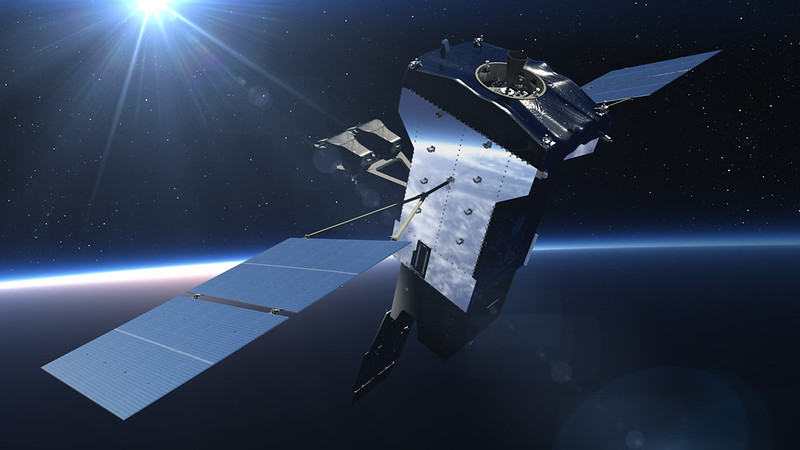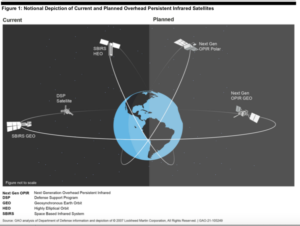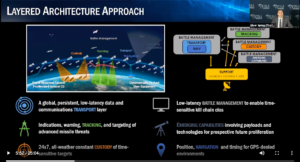
SBIRS GEO-5 (Lockheed Martin image)
WASHINGTON: The Senate Armed Services Committee is queasy about the status and interoperability of the Pentagon’s multiple efforts to develop missile warning satellites for various orbital altitudes, with lawmakers demanding that DoD report quarterly to the US Comptroller General on the status of the programs.
The reports, to include cost and schedule overrun risk mitigation measures, are designed to facilitate “periodic reviews” by the watchdog Government Accountability Office (GAO).
In particular, the SASC in its 2022 defense policy bill raises questions about how the satellites making up Space Force’s multi-billion dollar premier missile warning development program, Next Generation Overhead Persistent Infrared (Next-Gen OPIR), will be integrated with less costly efforts by DoD’s Space Development Agency (SDA), the Missile Defense Agency (MDA), and DARPA. The lawmakers also express concern about the need for risk mitigation as DoD pushes to get a multiple new missile warning sensors into orbit quickly.
The language in the SASC version of the 2022 National Defense Authorization Act (NDAA) was released on Sept. 22, the same day as a highly critical GAO report slapping the Space Force for knowingly providing Congress with overly optimistic cost and schedule estimates for Next-Gen OPIR.
The House Appropriations Committee, in its July report accompanying its draft 2022 defense spending bill, similarly slammed the Space Force for painting a too-rosy picture of the program, noting that a study by DoD’s Office of Cost Assessment and Program Evaluation (CAPE) has reached the same conclusions.
Next-Gen OPIR is designed to replace the 1990s-develop Space Based Infrared System (SBIRS) program, which notoriously faced a series of severe cost overruns and schedule delays, with the final satellite in that constellation only to be launched in 2022. Space Force plans to spend around $14.4 billion through 2025 to develop Next-Gen OPIR, and is using Section 804 Middle Tier acquisition authorities to push the program rapidly. 
The Space Force plans to launch the first of five Next-Gen OPIR satellites in 2025, a constellation called Block 0 to be placed in Geosynchronous Orbit (GEO, some 36,000 kilometers in altitude). Block 0 is the first iteration of satellites, composed of three satellites in GEO being built by Lockheed Martin, and two satellites in polar orbits, being built by Northrop Grumman. The service plans to transition Next-Gen OPIR Block 0 to a major capability acquisition pathway at the end of its five-year Middle Tier acquisition window, following the delivery of a prototype in 2023.
But Next-Gen OPIR, GAO says in its latest report on the program, “faces significant technical and managerial challenges … that are likely to delay the initial launch. Significant schedule delays typically result in cost increases. Although officials are aware of schedule risks, they continue to present an on-track timeline and stable cost estimates in reports to congressional committees.”
To stress its concerns, GAO added: “Reports to congressional decision makers that do not include realistic schedule estimates may prove counterproductive to the program’s ultimate success.” The watchdog agency recommended that DoD work more closely with Congress to provide greater transparency into Next-Gen OPIR, as well as its other missile warning efforts.
One of those troubling management issues for Next-Gen OPIR is that Space Force, via the program office under its new Space Systems Command, is itself — rather than as in the past the prime contractor — in charge of coordinating various pieces the complex development effort.
“A key issue facing the program is the government’s role as lead system integrator. The office within SMC acting as the lead system integrator is responsible for ensuring the space and ground segments of the Next Gen OPIR program work together. As such, this office is tasked with coordinating multiple prime and subcontractors to develop components such as sensors, software, and electronics across the space and ground segments,” GAO explains. “Although the Space Force has some previous experience acting as the lead system integrator on its Global Positioning System program, this is the first time the government will serve such a role for the missile warning capability area, according to program officials.”
To make matters worse, GAO reports, staffing for the job is lacking. “Specifically, the systems engineering area is understaffed and expected to remain so until the program awards a new support contract in mid-2021.”
Further, GAO finds, DoD “has initiated multi-agency efforts to determine how to meet future needs. However, coordination mechanisms are not formalized. Without documenting roles, responsibilities, and plans, DOD risks ineffective collaboration and unsynchronized delivery of warfighter capabilities.”
 SDA and MDA are working together to launch in 2024 a first iteration of missile warning satellites carrying sensors optimized to track high-speed, low-flying hypersonic missiles as well as ballistic missile launches. Those satellites are part of SDA’s overarching plans for multi-layered, multi-functional set of constellations in Low Earth Orbit (LEO, below 2,000 kilometers), called the National Defense Space Architecture. DARPA is contributing to the effort by prototyping various sensor experiments on teeny satellites.
SDA and MDA are working together to launch in 2024 a first iteration of missile warning satellites carrying sensors optimized to track high-speed, low-flying hypersonic missiles as well as ballistic missile launches. Those satellites are part of SDA’s overarching plans for multi-layered, multi-functional set of constellations in Low Earth Orbit (LEO, below 2,000 kilometers), called the National Defense Space Architecture. DARPA is contributing to the effort by prototyping various sensor experiments on teeny satellites.
GAO frets that currently, the Pentagon “does not have a long- term plan for how agencies involved with OPIR capabilities will meet future warfighter needs after Next Gen OPIR Block 0 is deployed.”
Space Force officials responsible for Next-Gen OPIR beg to differ with at least some of GAO’s findings.
“The Next Gen OPIR system is a critical cornerstone of our nation’s deterrence providing a Strategic Missile Warning capability that offers unrivaled performance and resilience against any adversary,” Lt. Gen. Michael Guetlein, new SSC head, told Breaking Defense in an email statement. “We openly acknowledge program risks to both OSD and Congress through frequent GAO and Congressional reports as well as engagements and are working hard to establish a unity of effort that allows us to optimize performance, cost, speed and resiliency.”
Col. Brian Denaro, SSC’s Development Corps program executive officer, in a separate statement, asserted that the program is progressing as planned. “The Next Gen OPIR program continues to deliver within cost, schedule and performance targets established at the outset of the program. To date, the Next-Gen OPIR program has hit every major milestone in support of an ambitious, but achievable launch date,” he said.
Denaro noted that the Next-Gen OPIR program has completed several reviews on schedule, and said that the “schedule critical path elements of the program, both contractors’ main payload prototype hardware and software, are on scheduled to complete testing in simulated space environments later this year (Fall 2021).
“These milestones directly contribute to and support an on-time System-level Critical Design Review in Fall 2021 and build confidence for Next Gen GEO Space Vehicle-1’s on-time delivery in 2025,” he added.
The GAO, for its part, says that DoD “partially agreed” with the report’s recommendation that formal coordination documents among the various agencies involved be developed and acknowledged a lack of established managerial mechanism, but “disagreed with our underlying finding that it lacks an overarching plan to acquire future OPIR systems.” In addition, the report notes, DoD in July told GAO that a “multi-agency team is collaborating on an Analysis of Alternatives Update study related to OPIR systems.”
Multi-ship amphib buy could net $900M in savings, say Navy, Marine Corps officials
Lawmakers gave the Navy authorities to ink a multi-ship amphib deal years ago, but the service has not utilized that power yet.


























